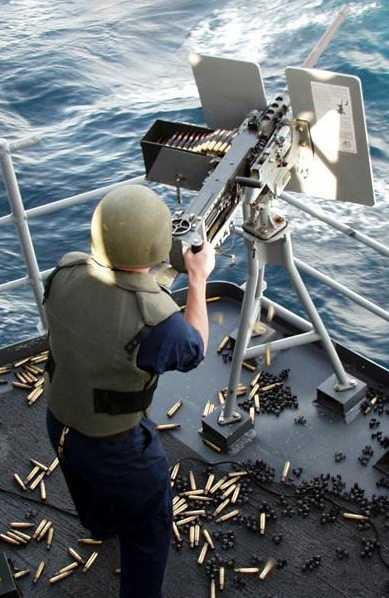|
This gun was initially designed near the end of World War I as an aircraft weapon. The design was modified for land use after the war and then designated as the Model 1921 machine gun. In 1932 the design was modified again and this design became the M2. M2HB (HB = Heavy Barrel), introduced during World War II, is the most common modern version and denotes guns using a thicker, air-cooled barrel, which was adopted in order to increase barrel life. In the 1930s, these guns in various forms on simple AA mountings were a common sight on most USN warships. However, with the start of World War II, the Navy quickly determined that they were almost useless against modern aircraft and replaced them as rapidly as possible with the 20 mm Oerlikon AA MG. In the 1930s and 1940s, the US Navy used a water-cooled version on ships while aircraft and small craft such as PT Boats used a lightweight air-cooled version. This latter version was the most common US aircraft weapon employed during World War II, used on both US Army and US Navy aircraft. The US Army fielded both a water-cooled model and an air-cooled version with a slower rate of fire. Today, the M2HB version is widely used by countless nations and ammunition for these weapons is currently manufactured in at least twenty countries. In the late 1930s and 1940s the Belgian firm of Herstal obtained a license and built guns designed to accept Hotchkiss 13.2 mm ammunition. Many of these were used on French warships of the period. All versions of this MG are recoil-operated and fire with a closed bolt, although at least one company is currently offering an adapter kit to convert this weapon into an open-bolt type. As a personal note, I fired this weapon a few times during my military service. Impressive firepower and quite reliable, although somewhat on the heavy side. Barrel changes are complicated with the need to adjust head spacings before the weapon can be fired. There have been efforts to produce quick change models, but these are not widely used. The US Navy and Marine Corps have purchased a small quantity of the 0.50" (12.7 mm) M3M FN Herstal MG as a replacement for the aircraft version of the BMG and the Army is currently evaluating a General Dynamics replacement firing 25 mm "smart" ammunition. However, the M2 is plentiful and cheap and will continued to be in wide service use for quite some time. The data that follows is organized as follows: "Air-cooled" refers to the modern-day "heavy barrel" (M2HB) version which is currently employed by the USN as a light anti-boat weapon. "Water-cooled" refers to the 1930s-1940s naval version. "Aircraft" refers to the 1930s-1940s perforated barrel version used on aircraft and small warships. This datapage is not meant to be a complete listing, as there have been many variations of the M2 during its long career, with several models in service today. Instead, this datapage is intended to provide information on the most common versions used for naval applications. |

Modern-day air-cooled 0.50" (12.7 mm) Browning
Machine Gun
|
| .
|